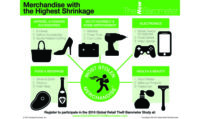“We did see an increase in loss prevention spending on equipment this year,” Bamfield says. “It made up 31 percent of total loss prevention spending in North America. It is getting through. The question now is how do you use it and where do you place it?”
Steve White., vice president and general manager at Checkpoint Systems, believes the key to the current retail security market is multi-functionality. “Everyone in loss prevention is challenged to extract the maximum value possible from their system now,” White told SDM in an exclusive interview, adding that executives are interested in finding surveillance products and systems that allow them to “better leverage investments and use video across multiple departments.” Retailers may be asking, for example, “How do I integrate marketing into loss prevention?” Products such as smart fixtures and public view display monitors that incorporate theft prevention features as well as customer-friendly displays and marketing materials have received an enthusiastic response from retailers, White says.
In addition, White observes that IP-based solutions, especially video analytics, have also garnered new interest. “Among retailers the shift to IP-based systems has been increasing much more rapidly in the last year,” White says. “There was a slow-down in 2009 but it picked up again in 2010. Retailers are looking long-term and seeing how IP can benefit them.”
Axis Communications, a company focused on the network video market, recently released the “Surveillance Survey Report,” conducted by the Loss Prevention Research Council (LPRC) and sponsored by Axis. This report surveyed loss-prevention executives from 49 national and regional retail companies in the United States, 98 percent of which currently use video surveillance in their stores.
Axis’ report found that while only 25 percent of the companies surveyed currently have an IP-based surveillance system, 87 percent of companies currently using analog surveillance technology stated they are “considering migration strategies toward network video.” This is consistent with Bamfield’s findings from his global report. Bamfield comments that 2009 saw the highest peak in shrinkage in recent memory, during a year in which retailers reduced loss prevention spending significantly. In 2010, some companies reacted to increasing losses by putting shrink management back on their agendas and revisiting long-term loss prevention strategies.
According to that report, the most popular loss prevention strategies in 2010 were employee pre-screening and education programs to better train employees to spot theft, which are both relatively low-cost initiatives. Another strategy which is gaining traction, Bamfield says, is data mining, which involves analyzing large amounts of data to find patterns and draw conclusions. According to his report, employees were the source of nearly 44 percent of shrink in 2010, making them the single biggest group affecting losses. “Data mining techniques are used to examine losses from mispricing or to identify people stealing,” Bamfield explains.
Global acceptance of IP technologies hasn’t developed overwhelming momentum yet primarily due to higher costs — or higher cost perception — but there is increasing dialogue on the topic, Bamfield notes. He adds that CCTV still has some strong supporters, the report showing that 19 percent of U.S. retail companies implemented new CCTV video surveillance systems in 2010 and 23 percent planned to do so.
In Axis’ report, 98 percent of companies state that video surveillance in general reduces internal loss, such as employee theft, and 75 percent claim that it reduces external loss, such as that caused by shoplifting or return fraud.
While the two reports are significantly different in scope and scale, both describe a retail market with a renewed interest in minimizing shrink — though retaining the ultra-cautious budget-consciousness which has prevailed in the last two years — and varying degrees of willingness to invest in long-term and/or advanced technology solutions. The market is currently characterized by a strong need to maximize value through creative solutions focused on deterrence.










